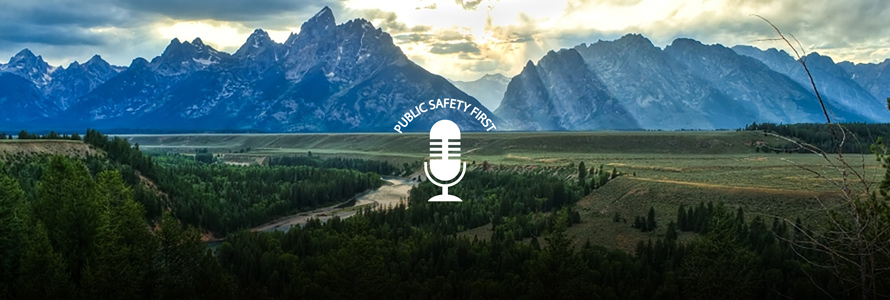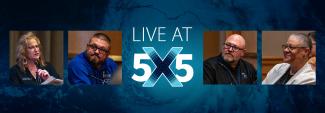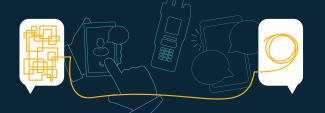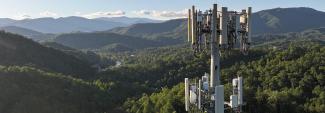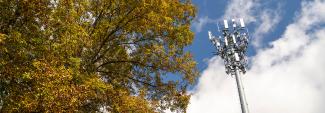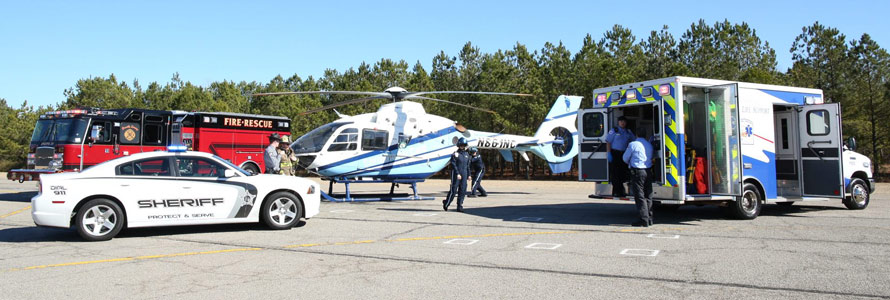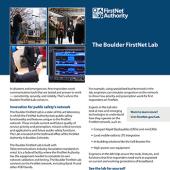Summary
Teton County is a rural county in northwest Wyoming. Situated in the Teton Range, the county experiences weather hazards including fires, floods, and wintery conditions, as well as earthquakes, landslides, and avalanches. Teton County first responders rely on FirstNet’s hardened network to stay connected in the most remote parts of the county and during tourist season when cell networks grow congested.
Guest
Tracey Murdock
FirstNet Authority Senior Public Safety Advisor
Rich Ochs
Emergency Manager, Teton County, Wyoming
Transcript
Preview
Narrator: You're listening to Public Safety First, a podcast to help you learn about the First Responder Network Authority and how you can be part of the future of public safety technology.
And now, your host.
Tracey Murdock: Welcome to the Public Safety First podcast. I'm Tracey Murdock and I serve as Senior Public Safety Advisor for the FirstNet Authority. Today, I'm joined by Rich Ochs, Emergency Manager for Teton County, Wyoming. Rich brings a wealth of experience to emergency management, serving as chairman of the Teton Local Emergency Planning Committee and as a Type III All Hazards Planning Section Chief. He's also the past president of the Wyoming All Hazards Association. Thank you, Rich, for joining us today and welcome to the podcast.
Narrator: You're listening to Public Safety First, a podcast to help you learn about the First Responder Network Authority and how you can be part of the future of public safety technology.
And now, your host.
Tracey Murdock: Welcome to the Public Safety First podcast. I'm Tracey Murdock and I serve as Senior Public Safety Advisor for the FirstNet Authority. Today, I'm joined by Rich Ochs, Emergency Manager for Teton County, Wyoming. Rich brings a wealth of experience to emergency management, serving as chairman of the Teton Local Emergency Planning Committee and as a Type III All Hazards Planning Section Chief. He's also the past president of the Wyoming All Hazards Association. Thank you, Rich, for joining us today and welcome to the podcast.
Rich Ochs: Thanks, Tracey. Glad to be here.
Tracey Murdock: Excellent. So, Rich, if you could just start by telling us a little bit about your background, what you do, how long you've been with public safety, and what your role is in Teton County.
Rich Ochs: Yeah. So, I'm the emergency management coordinator for Teton County, Wyoming. Done that since about 2007. Before that, I was a public safety dispatcher for Teton County, Wyoming, Sheriff's Office. And then before that, I worked for Grand Teton National Park for a little bit as a naturalist park ranger, not public safety. But I got to work with a lot of the public safety folks. I did some volunteering, driving for the ambulance, and I was a basic EMT for a little while. So, all that experience culminated into me getting into emergency management.
Tracey Murdock: Well, it sounds like you have the perfect background for emergency management with just a mixed bag of everything. Can you tell us about Teton County, the population, what's it known for, and a little bit about the area?
Rich Ochs: Yeah, Teton County, Wyoming, we're home to Grand Teton National Park and half of Yellowstone National Park. Tourism is our primary economic driver in our community. We have big surges in population. We're a county of about 24,000. However, with seasonal workers and especially visitors to our community, in the summer, we could see our population triple on any given day. Winter, we also have a surge because we have some of the best ski resorts in the country in our county. So, a lot of families, a lot of folks from other countries coming out to see some of our national treasures here. And we play host to a lot of people.
Tracey Murdock: So, given all that, what kind of hazards do you plan for?
Rich Ochs: It runs the gamut. So, we're pretty similar to the rest of the state of Wyoming where we, kind of, have three major disaster seasons that we can count on every year. We've got floods, fires, and winter. And so, typically our runoff flood season is anywhere from May through June. Our fire season comes next, which is typically a little later because we're at higher elevation. It takes things a little while to melt out. So, we're looking at a fire season anywhere from August through September, clear into October. And then winter can start any day of the year. We've had snow on July Fourth here, so, it's not outside of the realm of possibility, but generally, you know, roads shutting down, blizzard-type conditions, things like that, heavy snow, we're looking at anywhere from mid to end of November through about March.
So, those are the three big seasonal ones. And then we're in one of the more seismically active areas in the state of Wyoming and in the country. The Teton Fault, which runs about 40 miles along the base of the Teton Range, is capable of producing something in the range of a 7.0-7.6 earthquake. With Yellowstone, especially, the geothermal activity up there, we register a lot of earthquakes. Landslides are a big issue here as well. And avalanches because of the steep terrain all around the valley. And those tend to intersect with our major transportation routes.
Tracey Murdock: Boy that sounds like a lot to handle. OK, so we know you're a FirstNet customer. What led you to choose FirstNet?
Rich Ochs: Great question. So, we started talking to our FirstNet partners at AT&T and they were like, "Hey, do you know that you can actually get the same plan that you have, a better plan, with unlimited text, data, you'll get priority, preemption and you're going to pay less money." And that's what really, for the folks that are holding the purse strings in the county, were like, "Well, that seems to make sense. Let's get our first responders over on to this." And we switched over pretty early. And we're a very small division. I'm only two people in emergency management. I fall under the fire department, but we managed to talk the fire department into switching over, our sheriff's office, and then what I was very surprised with was the uptake by our volunteers. So, we have a combination fire department that has both paid and volunteer staff. But those volunteers that were paying for their own cell phones that weren't issued one by the county, the uptake was pretty good. A lot of them switched over on their own. And they spoke to us about how easy it was for them to prove and verify who they were, get switched over to FirstNet. Our search and rescue is also all volunteer. A lot of them switched over to FirstNet as well.
And then what we saw was an expansion of the AT&T network. So, we saw in the state of Wyoming, the more populated places started getting better AT&T coverage. We've seen expanded AT&T coverage in our county. And just learning about how AT&T is hardening their sites because of FirstNet, you know, the fact that they are redundant with power, the fact that they have required uptime – all of these things made us realize that this is the network that we want to be on. And that was one of the main reasons that we switched over to FirstNet. And we're finding that it's working. It's working really well for us.
Tracey Murdock: I love to hear that, Rich, that's really great how well the network is working for you in Teton County. And I know we've talked about several of the capabilities and unique features that FirstNet offers because public safety needs them, specifically for emergency managers, like FirstNet Central. As you know, you can go to the online portal and it allows administrators or emergency managers to do unique things like Uplift users to a higher priority. It gives us a view of the network status maps to get that real-time update and other tools that emergency managers might find useful in an operating setting. Tell us a little bit about your experience with FirstNet Central.
Rich Ochs: The FirstNet portal is incredibly useful from an emergency management standpoint. The fact that I have access, as an admin, to our FirstNet portal means I could see who in the county has it. I have the ability to turn on and off features without even talking to a customer service rep, and during an emergency where we may need to flip on a hotspot for a particular user and then turn it off afterwards because they need it for the emergency. That's incredibly useful.
So, something else I found really interesting about FirstNet in general was the Uplift. Locally, we have one school district in our county and they signed up for FirstNet. Then we found out that our local co-op power utility provider for the entire county, they signed up for FirstNet. And then we found one of our primary tow companies that help us with collisions and stuff like that, they signed up for FirstNet. And what we sometimes hear from first responders, which I have to counter, is that, "Well, FirstNet, why are these other groups signing up for FirstNet? Why isn't it just the police and the firefighters?" And I have to explain to folks that we want the utility company, we want the tow drivers, we want the school district and their school buses and their school bus drivers, if we have a major disaster, if we have that 7.6 earthquake in our valley, we want everybody coming to the party and we need them to help. And if they don't have effective communications, they can't help. And once I explain to them, "Well, you see, they're on FirstNet, you know, it says FirstNet on their phone, but they're actually not getting all the FirstNet features until they're uplifted. And that has to be done through me." So, through the emergency operation center I work with them ahead of time. I build lists and spreadsheets of their employees and we pre-populate the portal with that. So, during an emergency, I could just uplift their phones automatically. We've done it with our utility provider. We had a pretty significant windstorm come through the area, took down a lot of trees, a lot of power lines. And I just uplifted their phone for 24 hours. I'd rather uplift and have them on the system than have them try to make calls and not be able to get through and things like that. So, yeah. So, we did it and it worked really well. The portal was really easy to work through, really fast to log on.
And we have used the map. I sign up for the email notifications when there are system outages for AT&T in the predefined area that I set on the map. If I get an email and it's like, "Hey, you're having an outage, you may not be able to send text messages on AT&T’s network," I'll go look at the map at that point. But yeah, the email notifications have been really helpful.
Tracey Murdock: Yeah. How has that changed your operations or do you have an example of how it helped communications or situational awareness?
Rich Ochs: We're becoming so dependent on mobile devices. It's no longer a world where the VHF radio that you carry is your only situational awareness tool. For situational awareness, I think just the fact that we know that we have the data connection and that we can use apps that may have higher data demands, so ArcGIS would be a good example on our mobile device in the field. Our CAD system that we access. I can access that on my phone and knowing that I can rely on the network that I'm using to get that data onto my phone has been really helpful.
During the summer, the town square in Jackson is a very popular place for people to visit. And if you're on vacation, you're not really on vacation if you don't have a video or something to post on Facebook or Twitter or Instagram, right? So, everybody's using data. Everybody's using their phone to record and immediately upload or even stream, you know, or they're texting their friends. So, everybody's using the network. And you'll have times in the summer where you try to make a call and you get the "cannot be completed as dialed" on your standard cell phone. FirstNet, I never have an issue with Internet slowdown on my device, even when I'm in the more rural areas of the state. You'll see folks that are complaining about internet coverage and mine works. So, I've seen it work firsthand. And it's been a great tool for us.
Tracey Murdock: That's great to hear. So, earlier you mentioned that you have an extensive winter season and I imagine it presents its own unique challenges for public safety. How is FirstNet helping during these busy months?
Rich Ochs: We have essentially five ways out of the county and all of them are either through canyons or over mountain passes. So, we've had stretches of several days where every route in and out of the county is closed due to either avalanches or terrible weather conditions. You know, having my FirstNet device, having the hotspot, knowing that I have unlimited data and knowing that my battalion chief vehicles have that, knowing that other folks have it, it allows us to access the tools that we can use to then communicate and work remotely. So, during the winter, things like being able to access our WebEOC system allows us to now communicate. And we don't have to risk people coming in and making that dangerous commute to get to work, and they could still perform coordination activities remotely.
And honestly, especially after COVID, we've really changed our thinking on how our emergency operations center is going to be staffed and how it's going to work moving forward. We realized we can be just as effective, if we're familiar with the tools that we're using to work remotely. But those tools are only going to work if we have a reliable connection. That reliability, knowing that FirstNet is giving us the internet speeds that we need means that we can access those apps and that we can coordinate that communication. I could be snowed in at home and not be able to get into work and still be able to use my FirstNet device. I could be across the state and still be able to use my FirstNet device and be able to access the internet and do all these things.
Tracey Murdock: That's great to hear that it's working as it envisioned. How about FirstNet deployables? Have you ever used a FirstNet deployable?
Rich Ochs: No, we haven't. So, we sat through some of the webinars on wildland fire use. I have a lot of my Forest Service folks are very interested in it. The deployables are definitely something in the back of my mind when I'm trying to work on my local partners, when I'm selling them on the benefits of FirstNet, I'm like, "Hey, here's the deal. It was part of FirstNet. Part of their contract is to have these deployables available. But if they get set up, we need to be on this network. You have to have devices to work with it. It does come with devices. We can get those, too. But it'll be just much easier if you already have a FirstNet device and they can set up the deployable and we could start working off of it in the event that we have a large wildfire that, let’s say, burns up some of our communication sites." I have not had the experience of actually activating and calling one, thankfully, but I do know it's in my back pocket. And what I've seen in the demos have been, has been pretty incredible.
Tracey Murdock: So, you're used to talking with emergency managers from across the state. What advice or guidance would you give your colleagues, whether it's Wyoming or across the country, who are considering FirstNet?
Rich Ochs: If you have the coverage, to me, the switch is kind of a no brainer. For what you pay for the plan on AT&T and what you get as far as texting, hotspot data, priority, preemption, the access to deployables, all of this stuff that you could never plan for, you could never have all these tools in your community, especially a community in Wyoming where, you know, our biggest cities are 55,000 people. We don't have jurisdictions big enough to maintain this type of equipment and keep it here. It makes sense. And I encourage them, even if they're on another provider, even if they're not thinking of immediately switching over, to stay in touch with a FirstNet rep just so they can learn about the build out. And there's a lot of other tools on the horizon, a lot of other technology on the horizon that you don't want to miss the boat. And I would say, you'll be surprised with how quickly the coverage is growing. We've seen definite improved coverage. And we know that those sites that are going in are getting upgrades to Band 14. And we know that they're backed up with generator, which we've had issues here. We've had long term power outages that lasted over a week where cell sites went down within 45 minutes because they just didn't have the backup. And we know now that the FirstNet sites that are going in have that power backup. They will be up and running if we have those power outages. So, I just tell people to stay in touch with their FirstNet rep.
Tracey Murdock: Where do you go for your information about FirstNet and coverage like this new technology that you're talking about?
Rich Ochs: So, the FirstNet Authority webinars have been really helpful. I would say also learning about it at conferences. So, especially the International Association of Emergency Managers, there's been really good FirstNet representation there and just hearing what's in the pipeline and what's coming out, and what's being developed. Knowing what the system is capable of and also what the system engineers, what the policy makers, their vision for where this program should be going, I think is something important for all emergency managers.
Tracey Murdock: Rich, you recently requested a copy of the Inject Catalog. For folks listening, the Inject Catalog was designed by the FirstNet Authority to help public safety work broadband and mobile devices using mobile data into their training and exercises. So, we're used to using our radios and the Inject Catalog is just a tool to help emergency managers expand their training. Rich, how are you finding the FirstNet Inject Catalog helpful?
Rich Ochs: The FirstNet Inject Catalog is really going to help us to develop functional exercises. I'm always looking for ideas. That's kind of the toughest part of designing an exercise, especially a functional exercise, is coming up with realistic injects that get people thinking and talking about the issues, but also force them to react and to test their plans and things like that. It was great because there was a lot of functional injects that were, of course, geared towards first responders. But there was a lot of stuff geared towards dispatch centers, which I really appreciated because I tend to find that with exercise design, unfortunately, the dispatch centers tend to be an afterthought. And I think that hurts a lot because it doesn't give them a chance to exercise contingencies. It doesn't give them a chance to go through those critical thinking exercises where, "Well, what if this and this goes down? How are these systems tied together? What is our backup? Will our backup work if this thing goes down?" And the injects were really nice because there were quite a few geared towards dispatch centers. And even if you don't use them directly, they're going to be the jumping off point for you to get those creative juices flowing and create really good injects to get your dispatch centers involved in exercises. So, I'm excited about that. I'm excited to share it with other emergency managers in Wyoming, as well.
Tracey Murdock: Thank you, Rich, for taking time to speak with us today. And it's been great to have you on the podcast.
Rich Ochs: Thank you, Tracey.
Narrator: Thanks for listening today. We're excited to have you join our podcast community. Make sure to subscribe on iTunes, SoundCloud, and YouTube. You can learn more about the First Responder Network Authority at FirstNet.gov and learn about FirstNet products and services at FirstNet.com.


